The 13 Best Final Girls in Horror Movie History
We count down the 13 best ass-kicking leading ladies to survive horror movies.
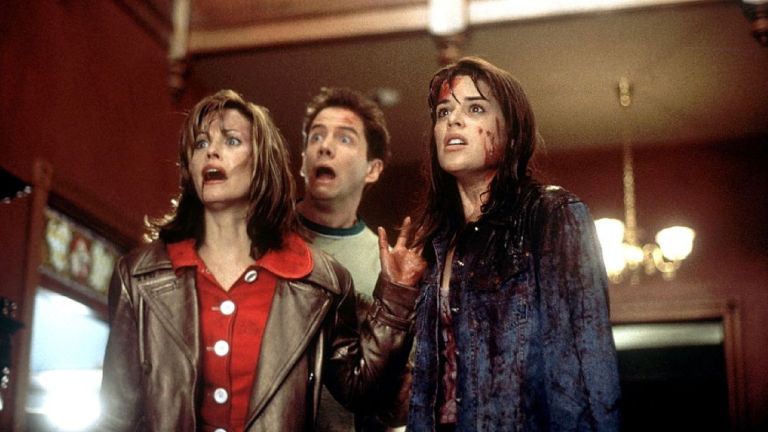
The term “final girl” is now as ubiquitous in horror culture as “slasher” and “jump scare.” The phrase was first coined by Carol J. Clover’s Men, Women, and Chainsaws: Gender in the Modern Horror Film, and it refers to a heroine (or “survivor girl”) who can be defined by several features: most obviously she is the last one standing after most or all of her friends have been sent to that big boiler room in the sky; she also is traditionally young, and has remained virginal and pure in the face of vice—making her far too innocent for a chainsaw’s sullying touch; and finally she must appropriate a masculine object to assert herself above the monster (i.e. pick up Jason’s machete and stab him right between the hockey pads!).
The contradiction of trying to create strong female protagonists who are usually still defined by the binary terms of “whore” and “maiden” is an obvious paradox inherent with this trope. And we’ve also seen it ignored, slyly mocked, and even celebrated in any number of horror movies. But this list aims to accept the type’s limitations while still finding 13 final girls who stood their ground and kicked serial killer ass while doing it! So join us as we look at the 13 best final girls. This list is in descending order with the best at the bottom!
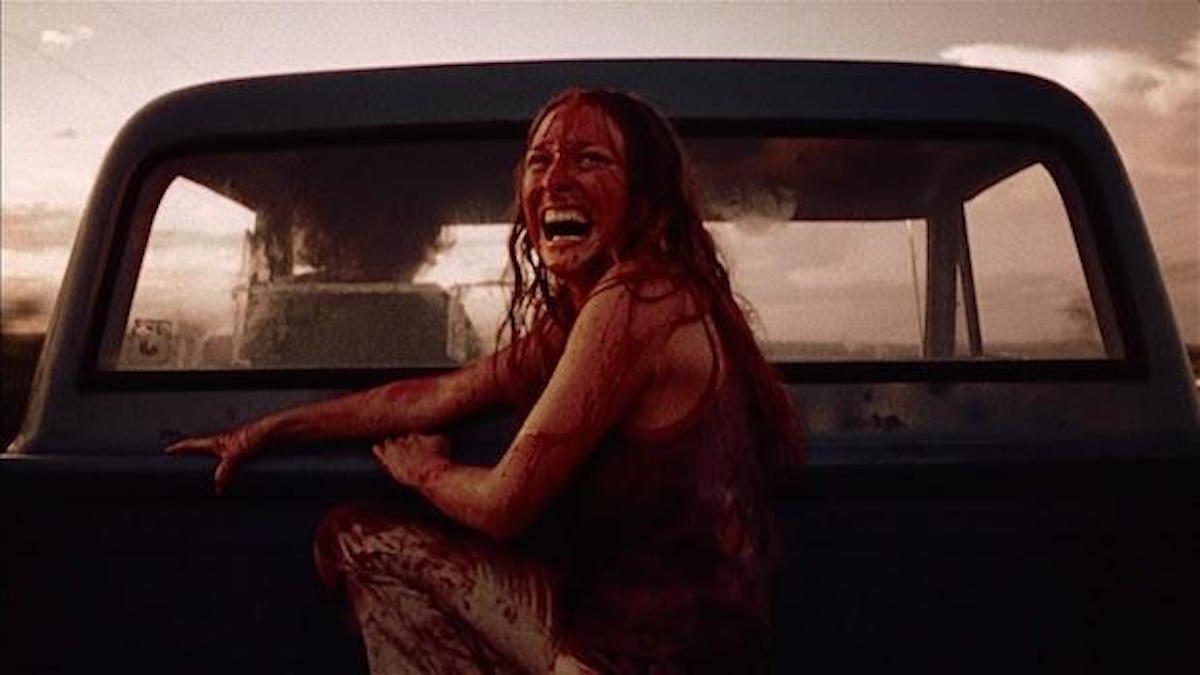
Sally Hardesty (Marilyn Burns)
The Texas Chain Saw Massacre (1974)
One of the best final girls is also one of the very first. Marilyn Burns played a wide-eyed and terrorized survivor girl before that even was a thing. And in Tobe Hooper’s film, she is forced to survive a whole hell of a lot worse than many others have in her wake. During the course of a leisurely summer afternoon, Sally sees her boyfriend, brother, and a whole slew of fellow walking clichés bludgeoned, carved, and slaughtered like a herd of particularly obnoxious cattle. And worst of all is when the Sawyer Family then invites her to dinner over their remains.
read more: How Low Budget Filmmaking Created a Texas Chainsaw Massacre
The Texas Chain Saw Massacre was one of the first slasher movies, and the concept had yet to be refined; the “Other” that gobbled children up still lay on the outside of society like a storybook villain. It also literally gobbled since the Sawyer family gorged themselves on any teen or fool stupid enough to wander from the safety of civilization. Thus this family of cannibals forces Sally to break bread with them while the family chef, cross-dressing Leatherface, sits in the next room, likely already thinking about tomorrow morning’s menu.
Sally herself is fairly reactionary as a character and survives more by luck than anything else. She doesn’t realize there is a threat until Leatherface has the chainsaw eight inches deep into her chatty brother and then she runs for her life. But in addition to being the first true final girl, she is also the one whose life was most evidently and believably scarred by the nightmare as the film closes on her covered in blood and laughing maniacally into a Texan sunrise while her getaway car takes the first off-ramp from hell—for Sally though, there’ll never be any getting off.
Watch The Texas Chain Saw Massacre on Amazon
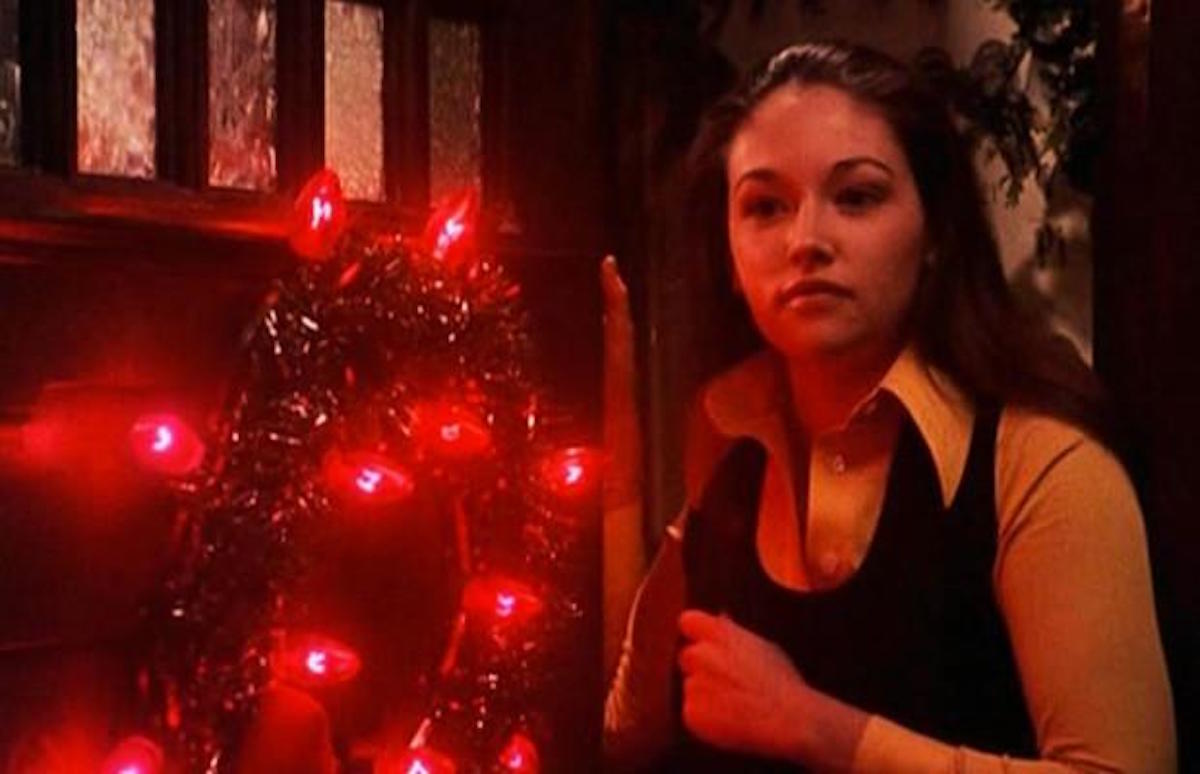
Jess Bradford (Olivia Hussey)
Black Christmas (1974)
Texas Chain Saw was not the only groundbreaking slaughterfest in 1974. Bob Clark also helped pave the way for holiday-themed massacres with Black Christmas, an underrated gem that will also forever be the quizzical prequel to Clark’s next Yuletide picture, A Christmas Story (1983). But on this earlier and far darker silent night, Clark imagines a sorority house where a serial killer hides in the attic as he slowly picks off the Greek sisters one by one over winter break.
read more: Best Horror Movies on Netflix
The final girl here is Jess, who is played with a genuinely emotional arc by Olivia Hussey. Released in the years before a final girl was a checklist box, Jess is a young woman whose personal struggles are still incredibly relevant today. In fact, it is hard to think of any horror movie now where the central heroine is in the process of getting an abortion. But in Black Christmas, Jess realizes she is pregnant and, without wavering, tells her temperamental artiste boyfriend that she is canceling the baby food orders. She then goes on to be the last sorority girl standing when it appears that boyfriend Peter (Keir Dullea) is the killer.
Of course, it turns out she was wrong to abort Peter’s skull from his body, but that kind of courage for a final girl (and only a year after Roe v. Wade) makes Jess unique in the genre and still one who should not be trifled with by masked killers.
Watch Black Christmas on Amazon
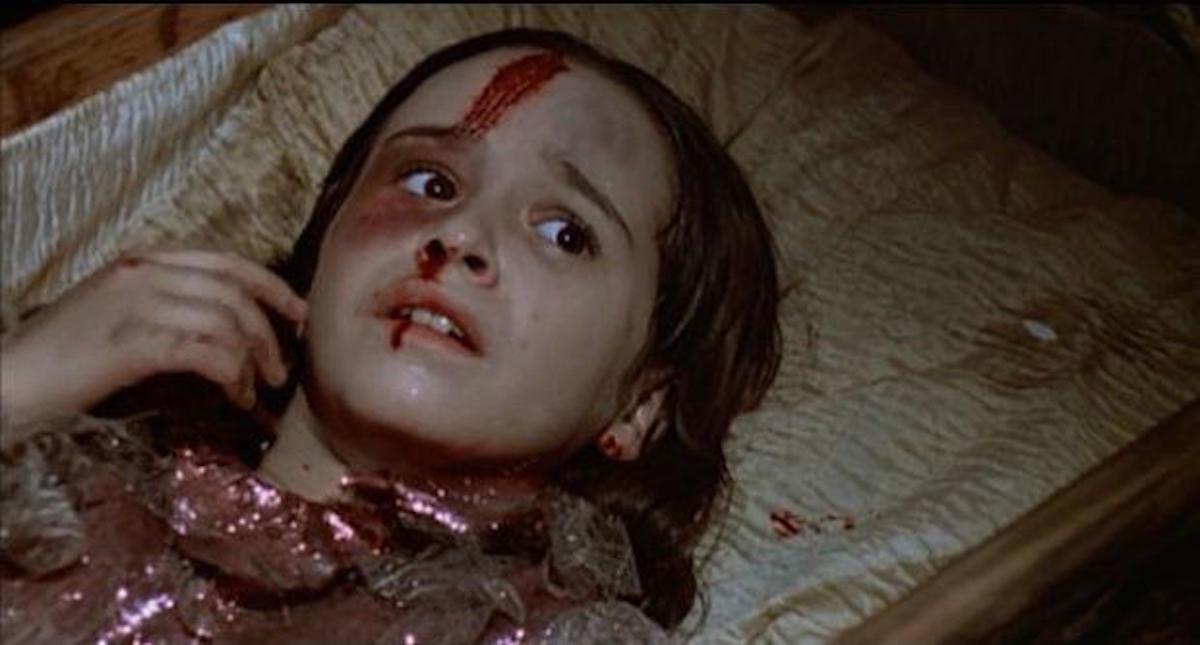
Jamie Lloyd (Danielle Harris)
Halloween 4: The Return of Michael Myers (1988); Halloween 5 (1989)
Jamie Lloyd is an especially rare type of final girl because she actually is a girl, and thus one whose danger is significantly heightened.
By the time producer Moustapha Akkad had jumped on the slasher icon train by resurrecting Michael Myers from the dead (Michael had clearly done the full Jacob Marley in 1981’s Halloween II), the slasher genre he’d helped define had passed him by. Now, the killers were the heroes with Freddy Krueger cracking wise in Nightmare on Elm Street sequels and Jason Voorhees never being anything less than a walking joke in the Friday the 13th films. And they all were driving into the ground a formula that John Carpenter’s original Halloween had perfected.
So if Michael Myers was going to compete with his fellow knife-wielders, any distinction would be crucial—and making the franchise revolve around an eight-year-old girl proved to be a cunningly singular difference. Whereas the survivor girls in other horror movies were becoming as disposable as their dead friends, this ostensibly orphaned daughter of Laurie Strode from the original Halloween continued the “Myers Curse” in a much more immediate way with her very real innocence in constant danger of being hollowed like an overripe Jack O’Lantern.
read more: Halloween Timeline Explained
Danielle Harris does pretty well for a child actress in this role, particularly in her second entry where her pantomime expressions (the terror of the fourth movie left her mute) allow her instant sympathy—a trait long lost in most horror movie heroines. Also, she sells the hell out of the scene where she finds her dog and adopted sister turned into festive lawn ornaments.
Despite the movies’ varying quality, the fear and guilt in little Jamie Lloyd’s eyes in the face of all this death is what kept the Halloween franchise in the realm of horror (as opposed to self-parody) a little longer than the competition.
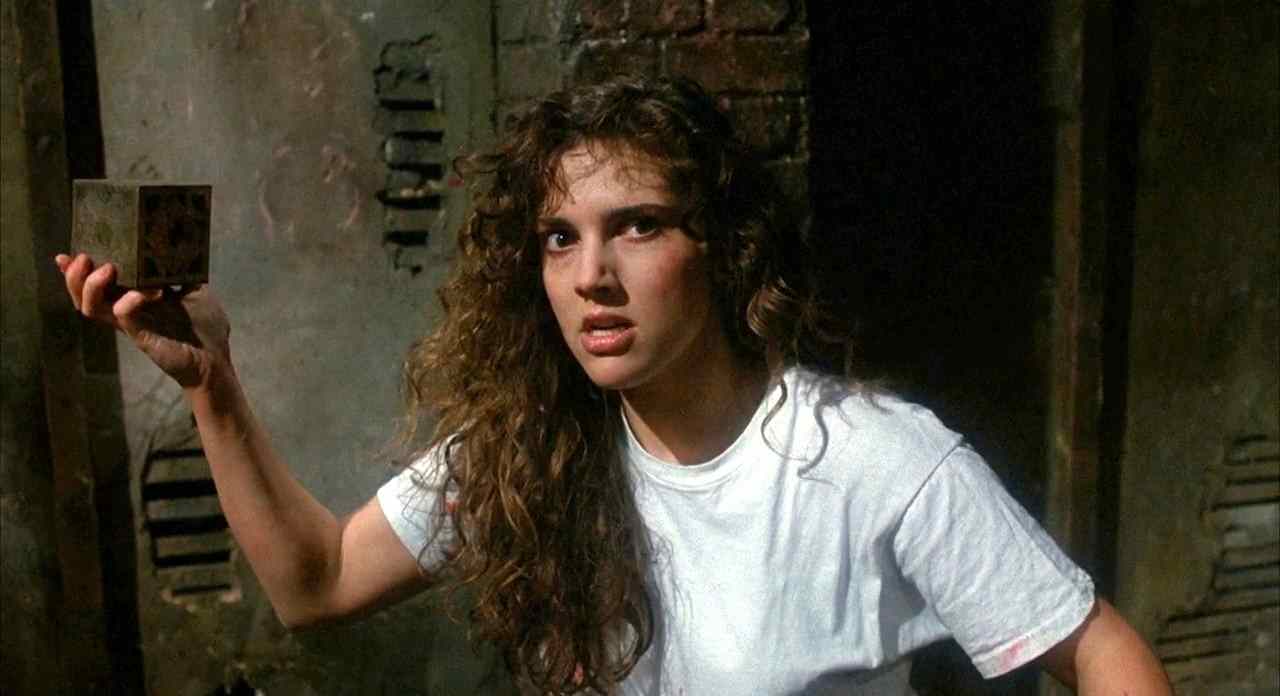
Kirsty Cotton (Ashley Laurence)
Hellraiser (1987); Hellbound: Hellraiser II (1988); Hellraiser: Hellseeker (2002)
Clive Barker’s sadomasochistic fantasia is probably not a slasher film in the traditional sense. To call it that would understate the nasty brilliance of what is at work in this gory passion play where BDSM meets Lovecraft. At its essence, Hellraiser is about people unknowingly calling down a demon known as “Pinhead,” the lead Cenobite. And whether they acknowledge it or not, they subconsciously are yearning for their own flaying.
In this demented context, Kirsty Cotton is unique in her relationship to her would-be tormentor. Repeatedly, she finds herself in situations where she has summoned the Cenobites into her world, and despite there always being a narrative logic to it, Pinhead (Doug Bradley) might have a point when he infers she wants to know the pleasures of exquisite torment. Of course she does not actually want to be skinned alive like Uncle Frank (Sean Chapman), but that dynamic of miscommunication is one of the more disturbing elements in the pantheon of heroine/monster relationships.
read more: Best Modern Horror Movies
Kirsty is generally at her best in Hellbound: Hellraiser II where she lives in the worst psychiatric ward in history and is powerless as her doctors open the gates to a realm of body horror once more. But this time, she is able to save more than herself. Courageously, she attempts to save her dead father from Cenobite torture and at least succeeds at saving another young woman from their clutches while making sure all the bad people in the hospital get what’s coming to them. This character growth of heroism (as opposed to victimhood) is a bit undone in the seedy direct-to-video follow-up Hellraiser: Hellseeker (2002), but the less said about that movie the better.
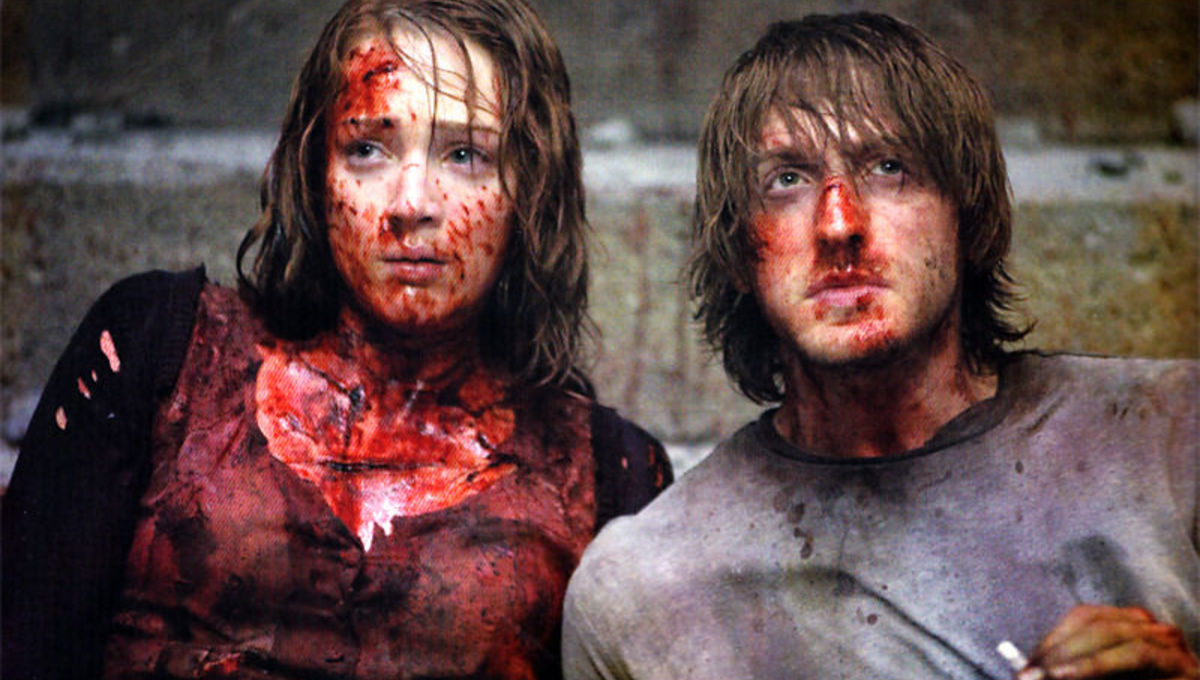
Dana Polk (Kristen Connolly)
The Cabin in the Woods (2012)
Drew Goddard and Joss Whedon have described their screenplay for The Cabin in the Woods as “a loving hate letter” to the horror genre. Yet we sense that the hate is more for the tropes, including final girls. Because everything else about this movie is just lovely.
Cabin in the Woods might be the greatest example of a “kitchen sink” mindset ever put to screen since every horror movie subgenre and stereotype is present, many of which are presented in grossly spectacular fashion. But at the center of it all is a scathing critique of the slasher formula, particularly with its antiquated attempts at feminism. While there is a final girl in one Dana Polk, played here with deliberate niceness by Kristen Connolly, she is hardly a progressive heroine when she is dumbed down with drugs into playing “the virgin,” as per request for a demanding demonic audience. Meanwhile, her equally intelligent girlfriend is manipulated by chemicals to be the harlot in need of punishment, and thus outdated gender roles are preserved.
read more – Sockin’ It to Sluts: The Horror Genre’s Troubling Trope
When Bradley Whitford’s working stiff waxes poetic about his phony concern for Dana as she faces imminent death, the irony and hypocrisy of horror fans rooting on the carnage while demanding a sweet girl next door hero is exposed (and without it feeling malicious and hateful of actual audiences like Michael Haneke’s Funny Games). But Dana and her stoner friend Marty (Fran Kranz) turn the stereotypes on their heads when they both live well into the third act—and Dana turns out not to be all that nice since she then chooses to protect her own status as the “final girl.” Survival becomes more important than morality when she points a gun at Marty.
This might not be what is supposed to happen, but it makes Dana one of the most memorable final girls on this list.
Watch Cabin in the Woods on Amazon
Sarah Carter (Shauna Macdonald)
The Descent (2005)
Ever since the 1970s, horror films generally are expected to have a survivor girl or two, but writer-director Neil Marshall does that one better in The Descent. Indeed, the all-female cast is one of the most intriguing things about what is one of the best modern horror movies.
In The Descent, six friends, whose shared history goes back to university days, reunite for an adventure deep in the Appalachian Mountains of North Carolina. They have gone on annual retreats like this for years, but shortly after a Scottish whitewater trip last spring, Sarah’s husband and daughter died in a car accident. At first glance, this getaway seems to be about burying the past—but really it is about burying their present animosity together.
This quest to go spelunking in unexplored caverns is overseen by Juno (Natalie Mendoza), the group’s erstwhile queen bee. But what is subtly being placed amongst these rocks and cave-diving ropes is an unspoken tension between these friends about how Juno was having an affair with Sarah’s husband, which may or may not have resulted in the fight that led to the car crash.
It’s never explicitly stated, but it is all there for when Sarah earns her right to be a final girl by taking a pickaxe to Juno’s knee and leaving her for the species of unidentified, flesh-eating monsters that apparently live beneath the Blue Ridge Parkway. When it is left to just Sarah and Juno, Sarah leaves Juno for them alone in the dark. It is a stunning moment that is informed for only the most observant viewers and makes the dark ending of Sarah being the final girl trapped in an inescapable cave even more haunting. Yes, there is a sequel that follows up on the happier band-aid ending shot exclusively for U.S. audiences. But let’s ignore that for the much more satisfying bleakness of the UK finale.
Erin Harson (Sharni Vinson)
You’re Next (2011)
Finally, we have a survivor girl who has a reason for surviving! In one of the most gonzo and off-the-wall horror movies in recent memory, You’re Next gives concrete logic behind its “home invasion” tropes, as well as to why the final girl was so much better than her army of masked killers.
After a Davison Family Reunion is rudely interrupted by mass murdering killers in animal masks, Erin goes from hunted to hunter and bags each and every would-be stalker before the end credits. The logic to this is that these aren’t actually unbeatable masked killers like other lazier home invasion thrillers (I’m looking at you, The Strangers); they’re simply members of the present wealthy family having the reunion. If they kill off all their parents, siblings, and nephews and nieces, then the fortune is theirs. Unfortunately for one member, he brought his girlfriend to the festivities and had no idea that she grew up on a survivalist compound in the Missouri wilderness. So while brothers might be easy to stab, good luck getting past her booby traps that result in a sledgehammer to the face.
Sharni Vinson’s final girl turns out to be a more unstoppable killing force than any poser in a costume.
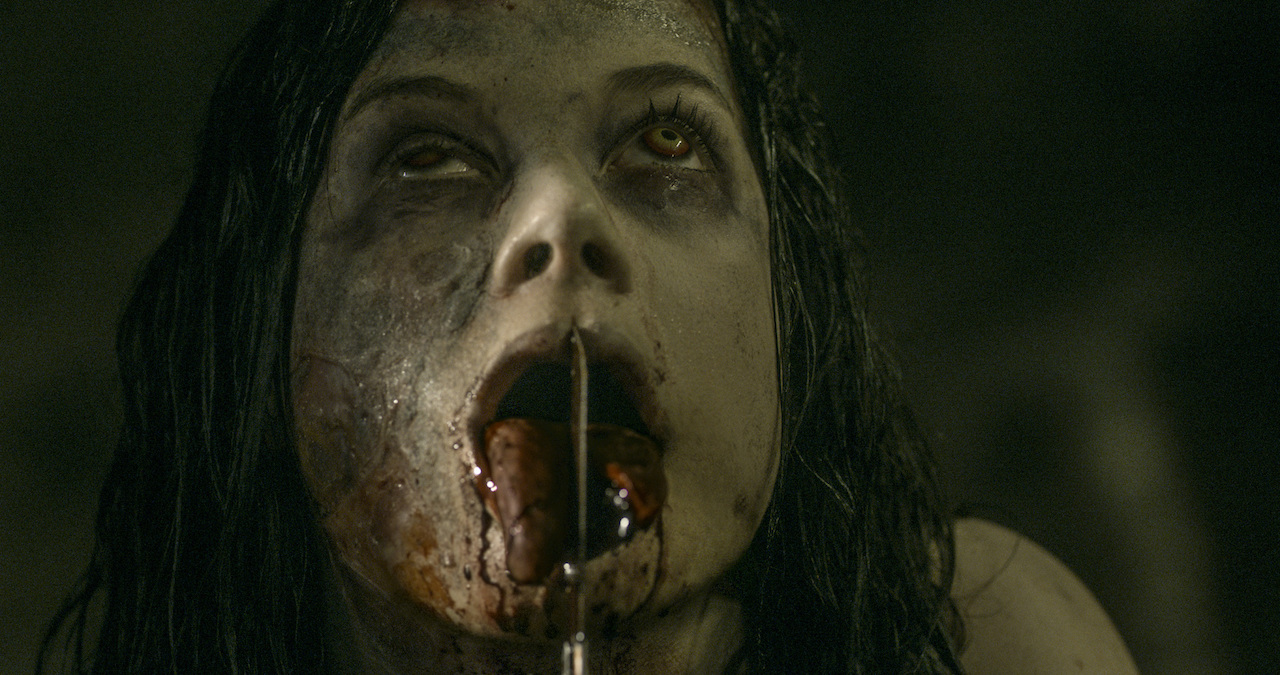
Mia Allen (Jane Levy)
Evil Dead (2013)
When Fede Alvarez did the unthinkable in 2013 and reimagined The Evil Dead, he made some canny decisions that helped his film stand apart from the original. And at the top of these choices was avoiding another Ash Williams/Bruce Campbell. Instead the lead character is the more traditional horror trope of a young woman. However, unlike any other final girl, Mia is also the lead antagonist of the film and spends just as much time demonically possessed as she does kicking demonic ass.
read more: Evil Dead Movies’ 24 Most Soul-Sucking Moments
Indeed, all of the best (or worst) moments of Evil Dead lore happen with Jane Levy onscreen in this film. Early on, Mia is the first victim who is woefully violated by a tree, much like Cheryl (Ellen Sandweiss) in the original film. However, unlike other Deadites, there is something cathartic about possessed Mia getting her revenge on all those who ignored and marginalized her as a paranoid ex-junkie. Mia also enjoys the most iconic moment of the remake when she splits her tongue in half to lay some sugar on another soon-to-be-possessed body.
By the film’s end, she also gets to be the hero who rips her own hand out from under a collapsed car so she can wield a chainsaw right between the teeth of an overconfident demon. “I will feast on your soul,” the Deadite taunts. “Feast on this, motherfucker,” Mia cries as she revs the chainsaw up and under the gum line. It is a glorious moment of triumph as hellish blood-rain descends from the heavens and a cabin in the woods burns like the souls of Mia’s poor, dumb friends.
After one film, it is not quite enough of an epic conclusion to say that Mia is on the same level as Bruce Campbell’s Ash. But we’d certainly welcome them to try and make that happen with the possible Ash/Mia crossover film that Sam Raimi has hinted at. Here is a final girl who got to be both the villain and the hero of her own movie. Who knows how she and Ash might interact with their dueling chainsaws?
Gale Weathers (Courteney Cox)
Scream (1996); Scream 2 (1997); Scream 3 (2000); Scream 4 (2011)
The Scream franchise has a very special place in the realm of horror. As the series that single-handedly reinvigorated both horror and slashers in the 1990s, it is the defining image of terror for an entire decade. But much like everything else from the Clinton Years, it was pretty self-aware and feel-good in its colorful happiness.
Perhaps that is why there are actually two final girls from the Scream films, and one of them is, of all things, an opportunistic reporter. Presented with a shocking level of empathy, Courteney Cox’s Gale Weathers is the quintessential tabloid journalist parasite with ambitions of becoming the next Barbara Walters (dare to dream). And it is those ambitions that keep putting her in the line of stabbing as the Ghostface Killer and his copycats keep on coming after Gale and company.
Another element that makes the Scream films unique is that the characters are all fairly well developed, and the survivors continue to evolve and change with each film. Well most of them. Gale is always the same determined journalist willing to break a story, no matter how many dead bodies she has to walk over along the way. But that sense of self-serving motivation makes her endearing in a way. Even if every one of her cameramen dies, she’ll still be there the next time Ghostface shows up along with her Scooby gang of friends.
Few horror franchises have a triumvirate of survivors. It might just be the greatest subversion of all.
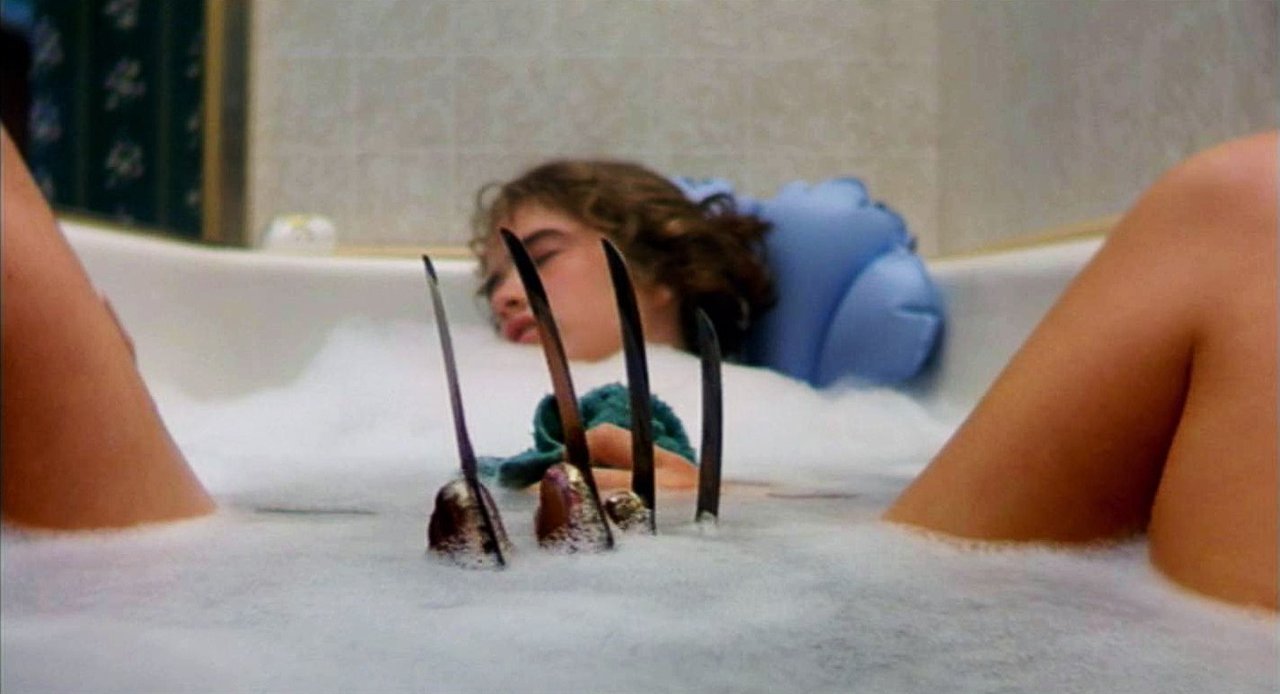
Nancy Thompson/Heather Langenkamp (Heather Langenkamp)
A Nightmare on Elm Street (1984); Wes Craven’s New Nightmare (1994)
There have been plenty of final girls, but none have had a grudge match so bloody with their monster that it spilled into the real world. But that is exactly what happened with the Nancy Thompson character in Wes Craven’s bookend films of the Nightmare on Elm Street universe.
No one in the original A Nightmare on Elm Street was bound to win an acting award in 1984—though the movie does mark Johnny Depp’s first big screen appearance—nonetheless the picture itself is memorably terrifying because of Robert Englund’s gnarly performance as Freddy Krueger, a filthy child murderer who was burned to death by parents out for some vigilante justice, as well as Craven’s nifty concept: after his death, Krueger returned from the grave as a dream demon to stalk the parents’ teenage children as they sleep. As Nancy’s iconic line advises, “Whatever you do, don’t fall asleep.”
In this context, Craven and Langenkamp depict their heroine as a teenager who is far less doe-eyed or victimized than the other horror protagonists of the ‘80s. In fact, Nancy is a quick learner who bones up by reading all the survivalist books in the library and sneaking coffee machines into her bedroom while her hair grays. Having as much of a foul mouth as Freddy, she proves to be his equal by pulling him into the real world and more or less defeating him via New Age spirituality. It wasn’t enough to stop sequels or a tacked on studio tease that Freddy would be back, but it made her memorably heroic and proactive in a genre defined by reaction. Even when she was obligatorily returned and killed off in Nightmare on Elm Street 3: Dream Warriors (1987), she comes back as a fighter looking to lock horns with Freddy’s dream devil.
This relationship between final girl and killer is so singularly personal that it became the crux of Wes Craven’s most self-aware and high concept thriller when he came back to end the franchise with New Nightmare. In the intervening decade between his ‘84 original and the ’94 denouement, Freddy had turned huckster, and each film became more outlandish in its dream escapades. By the sixth entry, the victims didn’t even matter; it was the Freddy show.
read more: Why Freddy’s Dead Is Not a Horror Film
That’s also what makes New Nightmare so strange, for in the series’ 11th hour, it returns to its roots with Freddy again being a monstrous dream demon that is barely seen. Now, he wants to cross over into the real world, and he is using his real-life creators of writer/director Craven and actor Robert Englund as the conduits. The only person who can stop him? His original nemesis, Heather Langenkamp, the performer who would be Nancy.
It’s a knotty concept that risks traveling into pretentiousness, especially as Craven throws real facets of Langenkamp’s personal life into the script like a special effects-expert husband and young son. But it mostly succeeds at making Freddy Krueger scary again in the most allegorical slasher ever attempted. It also elevates the story by ignoring the impulse to cast the monster as the star; this is a battle of good and evil, and a fight between Nancy and Freddy—the first final girl is resurrected as his equal without her ever donning a glove of claws or having to be “masculinized” to win.
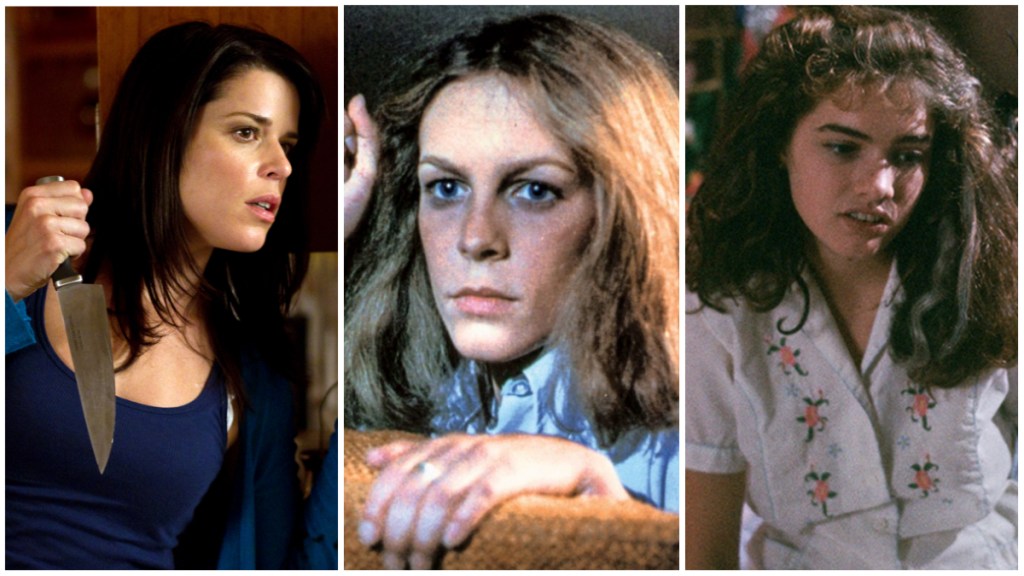
Sidney Prescott (Neve Campbell)
Scream (1996); Scream 2 (1997); Scream 3 (2000); Scream 4 (2011)
More than any other final girl in the pantheons of horror, Sidney Prescott is a fully realized character with a multi-arc journey. Even more impressive, however, is that Sidney is and always will be the star of the Scream movies—not Ghostface.
Whereas most horror movie franchises tend to deteriorate into showcases for the monster and the nubile young things he must skewer to the delight of horny teenage boys, the Scream movies maintained a surprising level of consistency. The first is inarguably the great film of the quartet, but all four have director Wes Craven and screenwriter Kevin Williamson’s fingerprints all over them, and they never forget that a killer is most scary when you’re rooting against him.
Thus enters Sidney Prescott, the first post-modern final girl in horror. For four movies, she is stalked by the legacy of Ghostface, a serial killer who was originally her boyfriend in disguise—but whose work was carried on by copycats and long lost half-brothers (don’t ask). Even if Ghostface’s weapon of choice (an innocuous phone call) never stopped being the central set-piece of each film, it was also never the star. The marquees here were Neve Campbell’s Sidney, David Arquette’s Deputy Dewey, and Courteney Cox’s Gale Weathers. There was also Jamie Kennedy as Randy before he got gutted like a fish in Scream 2.
Over the course of four movies, Campbell’s Sidney goes on a genuine arc and develops from each experience. In the first film, she is a prototypical ‘90s teen and virginal “good girl” ingénue. Yet, this is also the first movie to actually criticize the unspoken rule of “if you have sex you die.” Sidney does lose her virginity in the film and lives to tell the tale.
In Scream 2, she is battle-hardened and attempts to start a new life while dealing with unwanted celebrity. By Scream 3, she has lost two sets of friends and has dropped out of college to become an introvert and social recluse living in the woods while working for a suicide hotline. And in Scream 4, she has triumphed over all of the above by not letting her trauma define her. She is now a self-help author that has refused to go gently into that good night. Also during Scream 4, she’s no longer running from Ghostface, she’s running like a first responder into his house ready to drop kick him in the face.
Sidney Prescott is the pinnacle of the final girl archetype and one of the few who is a fully developed character that has a life beyond the confines of the screenplay. And thus she is damn hard to beat. Just ask the string of Ghostface killers she’s left buried along the way.
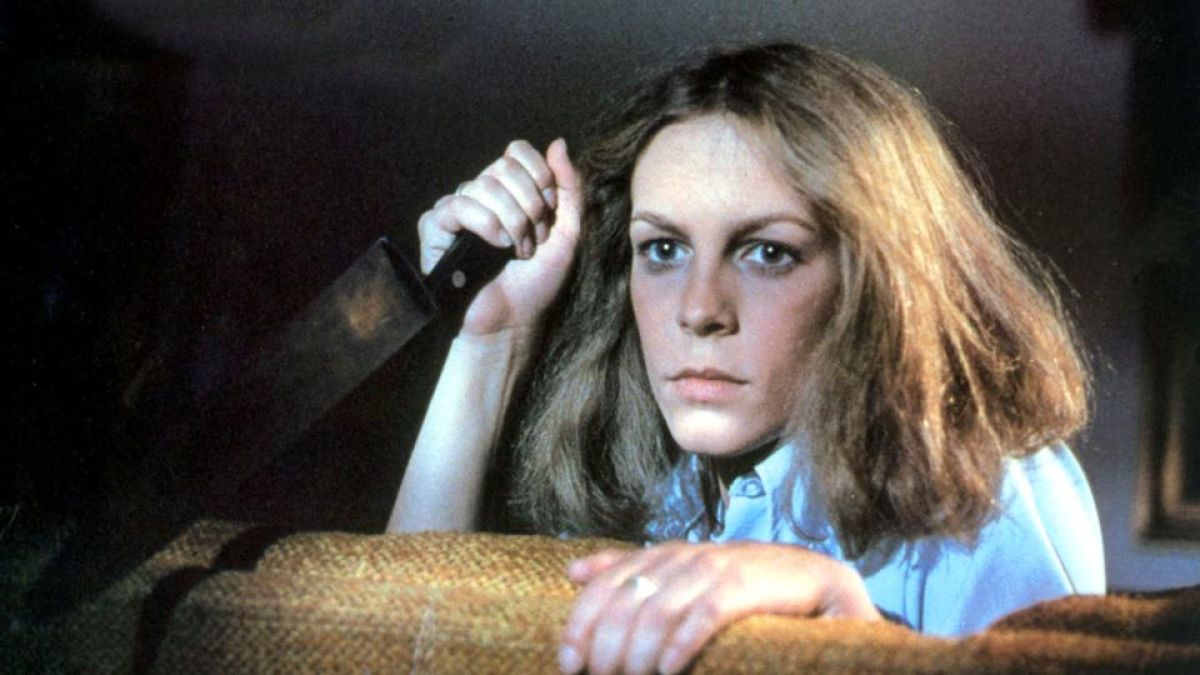
Laurie Strode (Jamie Lee Curtis)
Halloween (1978); Halloween II (1981); H20: 20 Years Later (1998); Halloween (2018)
But if Sidney Prescott is the pinnacle of the archetype, Laurie Strode is still nevertheless the definitive trendsetter. Played by Jamie Lee Curtis in the role that made her a scream queen legend, not to mention the true heir to her mother Janet Leigh’s Psycho legacy, Laurie is the young woman who stared into the face of evil and saw how disturbingly normal it can be. She then got the chance to kill it several times.
The beauty of John Carpenter’s Halloween is its simplicity. Ignore the sequels and take it as a one-off tale about a group of friends who are randomly and pointlessly targeted by a mass murdering stalker in a mask. There is no rhyme or reason for why he picked them; he just did so after being locked up for two decades following the senseless slaying of his older sister when he was a child. Michael Myers is the “Other” from Psycho and Texas Chain Saw brought home to suburban America’s backyard. His evil exists simply because. He’s literally credited in the film as “the Shape.”
In that sense, there is nothing to cheer or sneer about. Carpenter made the definitive slasher movie without realizing he was drafting a formula. Ergo, the three young women being stalked are relatively normal and believable people. Jamie Lee Curtis’ Laurie isn’t spared because she’s a virgin. She survives because unlike her friends she’s aware of her surroundings and has the ability to notice in time that someone is standing behind her.
read more – Halloween (2018): The Feminist Slasher Movie
It is admittedly a reactive performance: Michael chases her down the street and keeps trapping her in smaller and smaller places until she is finally saved by Donald Pleasence as a modern day Van Helsing. But unlike a number of performers on this list, Jamie Lee Curtis is a terrific actress and sells the horror of her situation in a way that makes that crumbling closet a little too real.
Plus in Halloween H20: 20 Years Later, Laurie gets the Scream treatment and has learned and grown from her trauma—she now is a very paranoid prep school dean with a drinking problem. She is also a helicopter mother, which proves to be a wise thing since her evil older brother (as retconned into the canon in Halloween II) returns from the dead 20 years later to try to kill her and her teenage son. Instead, Laurie chases him down and takes off his head with an axe.
Sure, Halloween: Resurrection (2002) later ruined this perfect ending to the Michael/Laurie feud and even kills off Laurie Strode. But like many bad sequels, it can be left to the dustbin of forgotten cash-in failures. Especially now–since this article was first published–David Gordon Green’s Halloween has corrected that mistake and offered a truly great ending to the Laurie/Michael Myers dynamic by going back to the randomness of it… and making Laurie the Shape who hunts Michael. The final girl archetype came full circle with the victim being the hero, and the binary conflict of male monster and female victim being brilliantly turned on its head by the definitive final girl. Make that final hero.
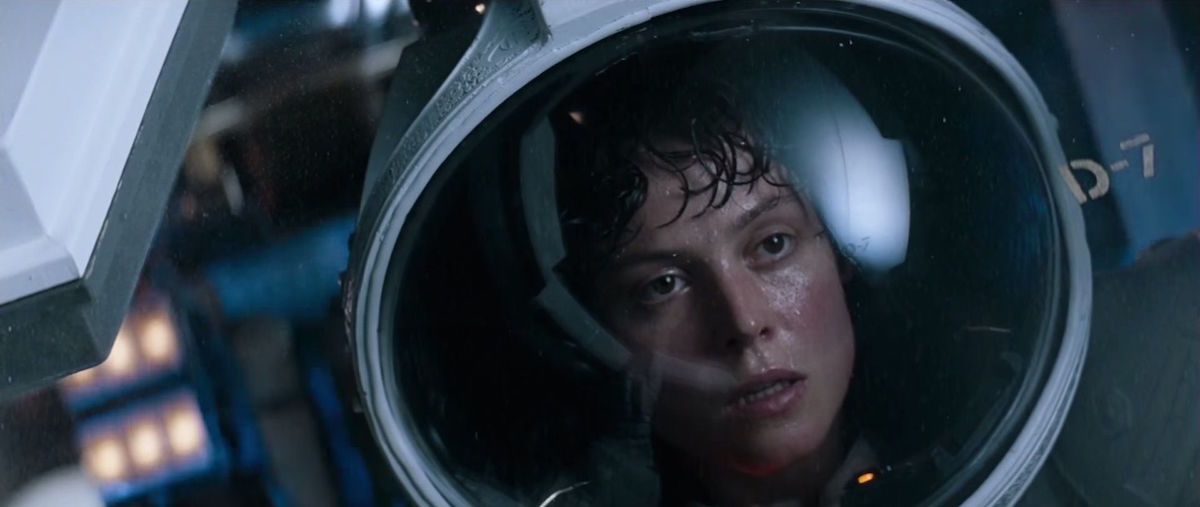
Ellen Ripley (Sigourney Weaver)
Alien (1979)
If you noticed up above, I did not include the long list of Alien sequels that Sigourney Weaver’s Ripley has appeared in. As great as James Cameron’s follow up is, that film and its successors were action movies. Just as this list will not include Linda Hamilton’s Sarah Connor or Charlize Theron’s Furiosa, it also is not focused on how Cameron turned Ripley into an action icon.
Nonetheless, before she was Cameron’s Ripley, she was the heroine of Ridley Scott’s psychosexual sci-fi thriller where she is the sole female survivor at the end of a film that sees all of her friends and colleagues slaughtered by an incomprehensible force. In short, Alien definitely qualifies as a horror movie, and henceforth Ripley is automatically the very best final girl the trope has ever produced.
read more: Are Alien and Blade Runner in the Same Universe?
Depicted as just another member of the space trucking crew, Ellen Ripley’s gender and sexuality are inconsequential. Indeed, Ripley was originally written to be a male role. However, this is not a case of a woman acting in a masculine way; this is an example of a smart and quick-thinking woman who is simply the best amongst her peers.
When her captain attempts to bring an injured crewmember aboard with an alien parasite grasped to his face, Weaver’s Ripley coldly and astutely attempts to prevent this breach of protocol. This alien parasite might endanger the whole crew—and it does. While everyone else panics, and a company stooge in the form of a robot (Ian Holm) secretly covets the alien species as a pricy corporate prize, Ripley follows the book and is already one-step ahead of her compatriots.
After the infamous chest-bursting scene, the film’s false hero (Tom Skeritt) quickly succumbs to the alien’s mysterious prowess and acidic capabilities. But Ripley figures out the crew’s cat is a lighthouse beacon that warns of the horror and she uses it as an alarm while fighting her way to being the sole survivor off the ship—she even gets to jettison the creature into deep space.
This role made Weaver a star and for good reason. She is unnervingly natural amongst a group of equally committed actors. Their parts are minimally written, but director Scott and his cast imbue them with great authenticity and life. And the one with the greatest desire to keep it is Ripley, who is played with unforgettable intensity by Weaver. She may not have gotten an Oscar nomination for the role until Aliens, which admittedly added a heartbreaking backstory to Ripley’s travails (in the director’s cut), but her performance was never more real or terrifying than when she locks eyes with both the H.R. Giger demon or Holms’ robotic machinations here. And then they blink first.
So there are the 13 Best Final Girls! Unless you think we missed one. If so, then let us know in the comments!
David Crow is the Film Section Editor at Den of Geek. He’s also a member of the Online Film Critics Society. Read more of his work here. You can follow him on Twitter @DCrowsNest.
